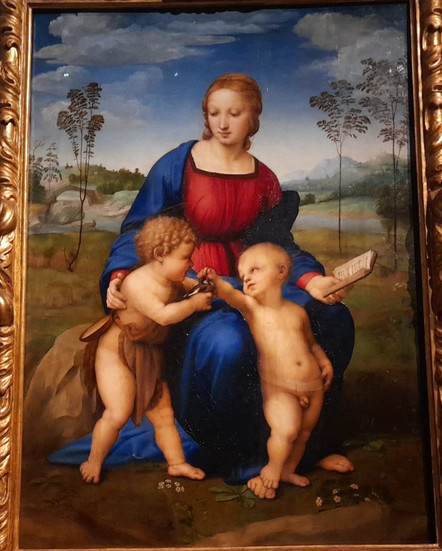Raphael: Renaissance Master Remembered
- Deborah Cater
- Apr 5
- 2 min read
Updated: Apr 7
On 6 April 1520, the world lost Raffaello Sanzio da Urbino, better known simply as Raphael. He was just 37 years old. Yet in that short life, he left behind a body of work that helped define the ideals of the High Renaissance.
Born in Urbino in 1483, Raphael trained under Pietro Perugino but soon developed a style that fused the clarity and grace of his teacher with the psychological subtlety of Leonardo da Vinci and the dynamic strength of Michelangelo.
His Florentine period produced some of his most loved works, including Madonna of the Goldfinch, Madonna del Prato, and later, Madonna della Seggiola, now in the Palatine Gallery of the Pitti Palace.
These Madonnas are not merely devotional, they convey tenderness and human presence, with soft lines and warm composition. Madonna della Seggiola, in particular, is often considered one of Raphael’s finest expressions of maternal love.
Florence is also home to some of his most insightful portraits. While the Uffizi no longer displays the Portrait of Elisabetta Gonzaga, it holds two especially important works: Portrait of Agnolo Doni and Portrait of Maddalena Strozzi, his young wife. Doni, famously, was the same patron who commissioned Michelangelo's Tondo Doni.
Rome calls
In 1508, Raphael was called to Rome by Pope Julius II. There, he began work on the papal apartments in the Vatican. The result was the Stanze di Raffaello, and among them, The School of Athens stands as a triumph of Renaissance thought. The fresco imagines an ideal gathering of ancient philosophers, set within a vast architectural space inspired by classical design. Raphael’s inclusion of contemporary figures, Michelangelo as Heraclitus, and even himself among the thinkers, adds a personal touch to this grand intellectual scene.
But Raphael’s talents were not confined to frescoes. His portraiture demonstrates an extraordinary sensitivity. In Portrait of Baldassare Castiglione, for example, Raphael captures not only likeness but intelligence and quiet authority. In La donna velata, he achieves an intimacy that still resonates five centuries later.
He also worked on religious commissions, including the Sistine Madonna, known for the two wistful cherubs that have become iconic in their own right. Yet the painting’s true emotional weight lies in the Madonna’s gaze, serene yet sorrowful, as if foreseeing the future awaiting her child.
Architect and archaeologist
Beyond painting, Raphael served as chief architect of St. Peter’s Basilica and played a role in the early documentation and preservation of ancient Roman ruins. His work straddled both the creative and the scholarly, embodying the full spirit of the Renaissance.
His sudden death on his 37th birthday sent shockwaves through Rome. He was buried in the Pantheon, the resting place of emperors, with an epitaph that reads:
“Here lies Raphael, by whom Nature feared to be outdone while he lived, and when he died, feared she too would die.”
Even today, his works speak with clarity, harmony, and compassion, qualities that continue to inspire artists and visitors alike.
















Comments